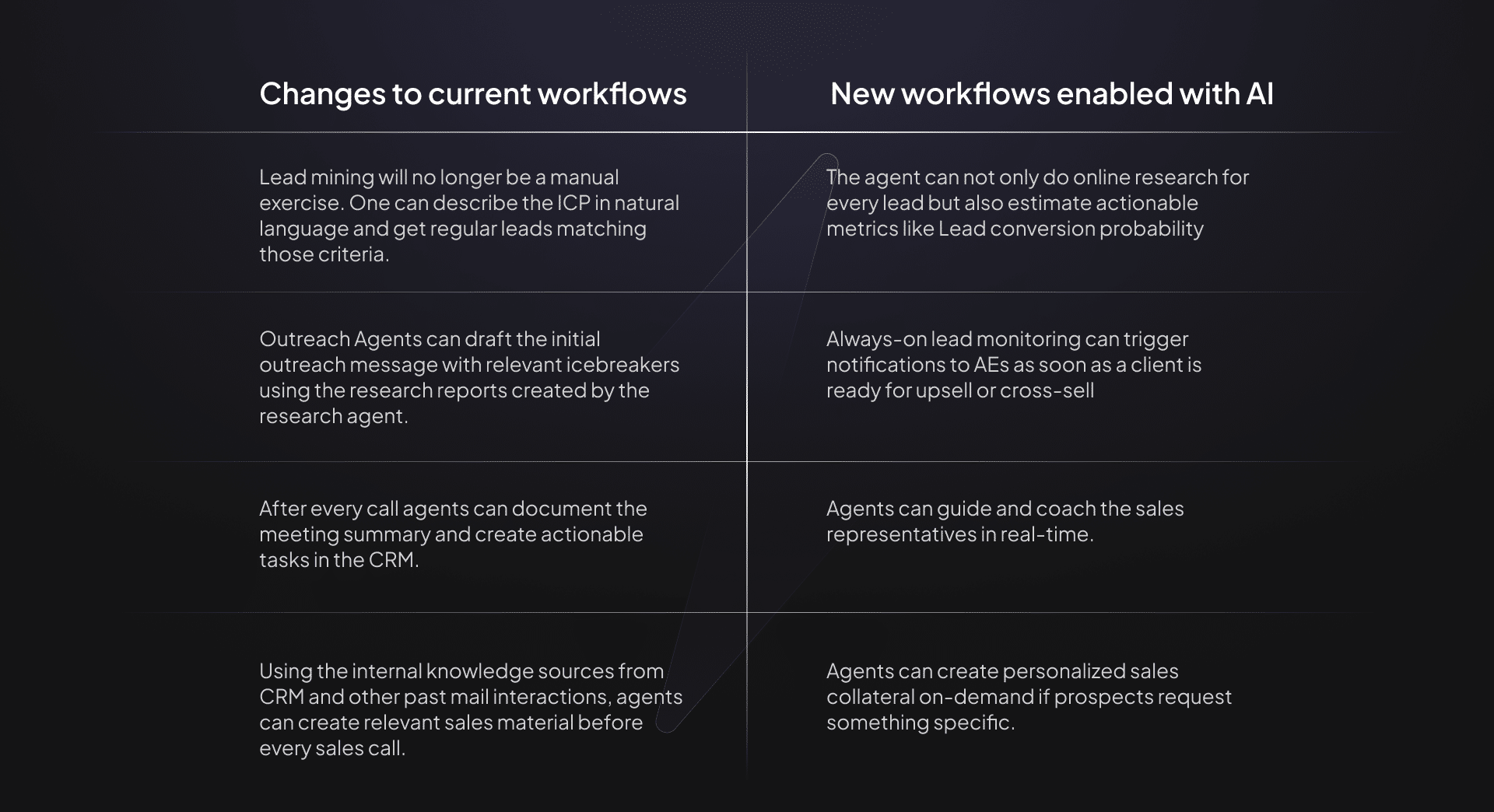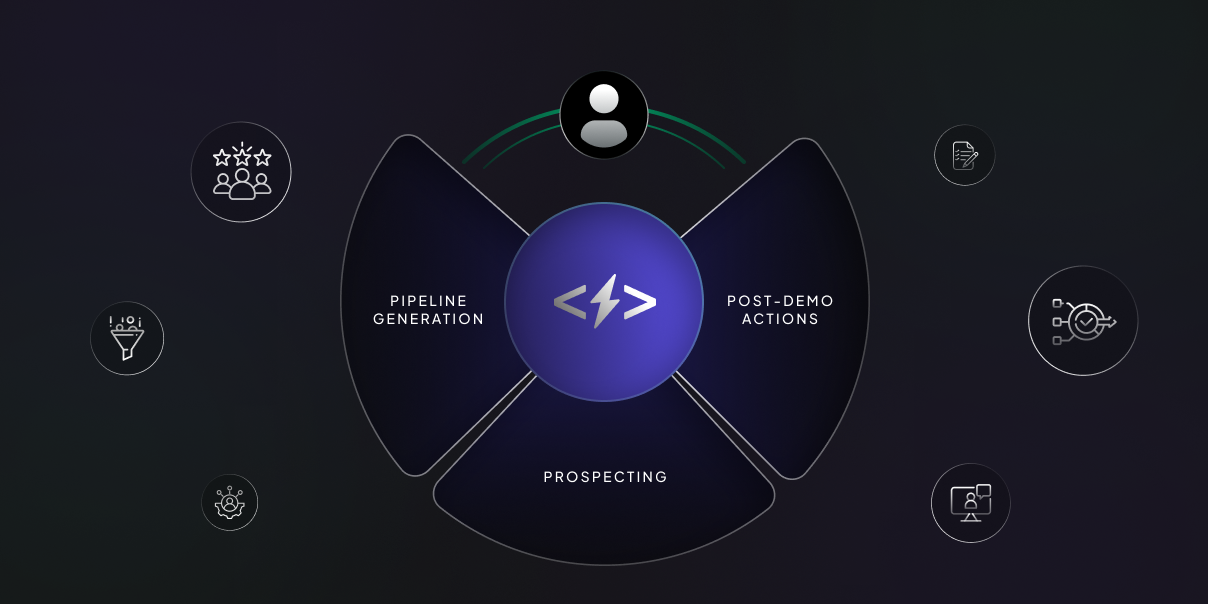The Software as a Service (SaaS) model began when Salesforce launched its “End of Software” campaign in 2000 and went public only four years later. At the time, people were still buying software in a box. CRM software like Siebel was incredibly difficult to run and required constant costly upgrades. Salesforce was different. Its product was a website. “No Software” was a value prop even non-technical people understood. CRM 2.0 marked a platform shift that brought new technologies (like the cloud) and new business models (like SaaS).
Today, we’re witnessing another platform shift to AI. We are ushering into an era of cognitive intelligence which means Software will no longer be a passive tool that needs to be operated by a human. The next generation of software will be active, like a living entity, not only working for humans but also guiding humans with AI-generated next-best actions.
While incumbents often adapt to new platform shifts, they rarely completely rethink their architecture. For the last 20 years, companies like Salesforce and HubSpot have survived because they are embedded as “Systems of Record,” meaning replacing them is a herculean task that sales leaders avoid. However, AI is fundamentally reimagining the core system of record and sales workflows to such an extent that the ROI in switching to a new AI-native stack is absolutely justified.
Three pillars of the new AI-native Sales Stack
- Multi-modality: The foundation of CRM 2.0 was based on structured representation of sales opportunities, using relational databases. With LLMs, the core of the CRM 3.0 will be entirely unstructured and multimodal, including text, image, voice, and video. A company’s sales platform could include data about existing and prospective customers from countless sources: recordings and transcripts from any conversation with someone at the company, emails and Slack messages, sales enablement materials, product usage, customer support activity, public news, financial reports…the list is endless.
- Hyper-Personalization: a16z’s General Partner Andrew Chen says, we only have marketing because 1:1 sales for everything is too expensive. Few things in business are more strategic than personalization because it makes your offerings relevant to customers. Need personalized marketing collateral for a deal? Your AI assistant can produce the assets you need and give you live tips during calls to help you close.
- Always-On Intelligence: With AI, sales teams won’t need to spend endless hours researching new leads or prepping for calls — AI will do it in seconds. Reps won’t need to gauge the readiness of potential customers because AI will automatically compile a ranked list of primed buyers and keep it updated. The next-gen system-of-record will constantly ingest data to create the most up-to-date context. In essence, the way sellers and buyers interact will be fundamentally different.
Sales Workflows Redefined
With AI-native foundations, common sales activities may be redefined or even disappear completely. At the same time, we’ll likely see new sales workflows that aren’t possible today.

Sales Stack re-imagined for AI-native workflows
Now that we have established that AI offers endless ways in which sales processes can be augmented as well as disrupted, the question arises: what will the new-age Sales Stack look like? Will it be radically different from current solutions or simply incremental features on top of the current stack? In our view, the ideal solution will combine the reasoning and acting capabilities of AI with the visibility and controls of existing software.
Just like hybrid cars, the best solution will offer the benefits of futuristic tech (high performance and efficiency of an electric powertrain) without the downsides of new technology (limited range of EVs). That is why we are working on a stealth product that provides the familiarity of incumbent CRMs but is built on a modern platform with actions as a core component for seamless collaboration between Sales professionals and AI Agents.
To visualize the full extent of how AI Agents can be applied to the sales process, we broke it down into its constituent steps.

There are three broad functions where AI agents can leverage their reasoning and action capabilities. Let’s analyze each stage to understand how AI Agents can create magic by interacting with an AI-native CRM!
1) Pipeline Generation
LLMs have enough reasoning capabilities to power AI Agents which get you Sales Qualified Leads (SQLs). The four steps involved here are: Understanding your ICP, Gathering leads basis the ICP criteria, Enriching those leads with external and internal data sources, and tracking the online activities of these leads to predict their Sales Readiness.
2) Prospecting
AI Agents can conduct deep research for every SQL and create personalized outreach messages with relevant ice-breakers. They can follow up with prospects via multiple channels (email, LinkedIn, etc.) and generate sales collateral on-demand if prospects request something specific. This is the stage where the reasoning capability of AI Agents becomes a real game-changer.
In prospecting conversations, one needs to be extra mindful as one wrong reply can burn the lead. Here, the AI Agent is not only responsible for responding to user queries reactively but also needs to drive the conversation actively by asking smart questions. The agent needs to understand the key pain points of the prospect and their propensity to pay before pitching the right product and asking to schedule a demo.
3) Post-Demo Actions
Note-taking and transcription tools aren’t as novel as they were in 2020. However, extracting the right action items and insights from meetings can significantly affect conversion probability. Another big reason that makes this step critical is the fact it completes the sales loop which helps in improving the efficacy of AI agents during the first two stages as well. For example, if AI Agents don’t have access to all the customer interactions, then they can make rookie mistakes like adding leads who are already in your pipeline or reaching out to potential customers too early or too late. We all know that sales professionals have as much love for data entry as developers have for documentation. With this in mind, this step is extra crucial to maintain the CRM in a state that allows AI agents to seamlessly do their jobs.
The birth of new dynamic organizations
So far, we’ve covered why AI won’t just augment existing workflows but will also replace and eliminate them. The only question is when. The main thing holding up operational transformation is people’s readiness to embrace the changes AI brings. AI doesn’t need a 6-month change management plan. Changes are instant and beneficial.
Fortunately, money isn’t scared of AI. C-level execs will push for readiness, and first movers will be rewarded with increased market share, just like in the early days of Search Engine Marketing and Social Media. AI adoption will not only boost organizational productivity but will also create new types of organizations. Let’s understand how!
Sales, marketing, and customer success will blend together
Today, sales, marketing, and customer success teams often feel siloed, with poor knowledge sharing and rough handoff processes. In the new age, all important customer contexts will be reflected in the same source of truth. As most activities are guided by AI, job functions could start to blend together. Sales, account management, and customer success may simply be seen as different ways of adding a human touch to go-to-market strategies. No more fighting over who gets credit for upsells — you could even imagine a world where quotas are redesigned to be more team-based than individual-based, accurately reflecting the opportunity for fluid collaboration throughout the sales cycle.
This collaboration will not be limited to employees but will also extend to the software stack. In the AI-native world, your marketing campaigns would likely be handled by Marketing AI agents integrated into your CRM. There may not be a separate tool for marketing – it could all be powered by the same CRM.
Fluid GTM Strategies
Today, companies usually decide where to focus resources based on target segments and annual contract value ranges, such as a top-down sales approach or an inside sales-assist approach. They often hire and build teams around a set strategy. These economic assumptions will look very different in an AI-first world. Companies may be able to reorient their resource allocation based on what’s best for the customer. For example, to close an account, what’s the best go-to-market approach? Currently, many companies choose to identify themselves as either enterprise-grade or developer-first. In the future, companies should be able to cater to both buyer personas with highly customized sales journeys.
Per seat pricing → outcome-based pricing
In this tweet thread, Alex Rampell breaks down customer support costs into two categories: Human and Software. The human-only cost per ticket is around $37.50, while the software cost per ticket is only $0.69. AI-based products could unlock instant ROI as they can replace humans altogether, which accounts for 98% of the cost. Under the new AI-first paradigm, companies will be forced to switch to outcome-based pricing rather than seat-based pricing. This change will also be welcomed by their buyers.
Conclusion
In the AI-native era, the triumvirate of Tech Stack, Workflows, and Business Models will be re-imagined all at once. The massive platform shift will uproot every incumbent that we see today, especially the large ones as they are the slowest to adapt. At the same time, the new-age Sales Stack must provide continuity in terms of UX so that businesses can undergo AI transformation smoothly. That’s why at SuperAGI, we are re-imaging the core software primitives from AI-native lens. Stay tuned for more updates!








